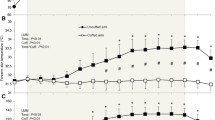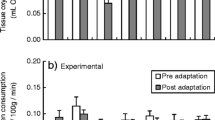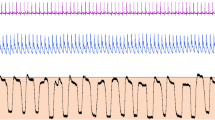Summary
During exercise in a hot environment, blood flow in the exercising muscles may be reduced in favour of the cutaneous circulation. The aim of our study was to examine whether an acute heat exposure (65–70°C) in sauna conditions reduces the blood flow in forearm muscles during handgrip exercise in comparison to tests at thermoneutrality (25° C). Nine healthy men performed dynamic handgrip exercise of the right hand by rhythmically squeezing a water-filled rubber tube at 13% (light), and at 34% (moderate) of maximal voluntary contraction. The left arm served as a control. The muscle blood flow was estimated as the difference in plethysmographic blood flow between the exercising and the control forearm. Skin blood flow was estimated by laser Doppler flowmetry in both forearms. Oesophageal temperature averaged 36.92 (SEM 0.08) ° C at thermo-neutrality, and 37.74 (SEM 0.07) ° C (P<0.01) at the end of the heat stress. The corresponding values for heart rate were 58 (SEM 2) and 99 (SEM 5) beats -min−1 (P<0.01), respectively. At 25° C, handgrip exercise increased blood flow in the exercising forearm above the control forarm by 6.0 (SEM 0.8) ml · 100 ml−1 · min−1 during light exercise, and by 17.9 (SEM 2.5) ml · 100 ml−1 · min−1 during moderate exercise. In the heat, the increases were significantly higher: 12.5 (SEM 2:2) ml · 100 ml−1 · min−1 at the light exercise level (P<0.01), and 32.2 (SEM 5.9) ml · 100 ml−1·min−1 (P<0.05) at the moderate exercise level. Skin blood flow was not significantly different in any of the test conditions between the two forearms. These results suggested that hyperthermia of the observed magnitude did not reduce blood flow in active muscles during light or moderate levels of dynamic handgrip exercise.
Similar content being viewed by others
References
Bean WB, Eichna LW (1943) Performance in relation to environmental temperature. Reactions of normal young men to simulated desert environment. Fed Proc 2:144–158
Bell AW, Hales JRS, King RB, Fawcett AA (1983) Influence of heat stress on exercise-induced changes in regional blood flow in sheep. J Appl Physiol 55:1916–1923
Brengelmann GL, Johnson JM, Hong PA (1979) Electrocardiographic verification of esophageal temperature probe position. J Appl Physiol 47:638–642
Detry J-MR, Brengelmann GL, Rowell LB, Wyss C (1972) Skin and muscle components of forearm blood flow in directly heated resting man. J Appl Physiol 32:506–511
Edwards RHT, Harris RC, Hultman E, Kaijser L, Koh D, Nordesjö L-O (1972) Effect of temperature on muscle energy metabolism and endurance during successive isometric contractions, sustained to fatigue, of the quadriceps muscle in man. J Physiol (Lond) 220:335–352
Grimby G (1965) Renal clearances during prolonged supine exercise at different loads. J Appl Physiol 20:1294–1298
Johnson JM, Rowell LB (1975) Forearm skin and muscle vascular responses to prolonged leg exercise in man. J Appl Physiol 39:920–924
Johnson JM, Taylor WF, Shepherd AP, Park MK (1984) Laser-Doppler measurement of skin blood flow: comparison with plethysmography. J Appl Physiol 56:798–803
Kim YD, Lake CR, Lees DE, Schuette WH, Bull JM, Weise V, Kopin IJ (1979) Hemodynamic and plasma catecholamine responses to hyperthermic cancer therapy in humans. Am J Physiol 6:H570-H574
Lind AR, Dahms TE, Williams CA, Petrofsky JS (1981) The blood flow through the “resting” arm during hand-grip contractions. Circ Res 48 [Suppl 1]: 104–109
MacDougall JD, Reddan WG, Layton CR, Dempsey JA (1974) Effects of metabolic hyperthermia on performance during heavy prolonged exercise. J Appl Physiol 36:538–544
Nielsen B, Savard F, Richter EA, Hargreaves M, Saltin B (1990) Muscle blood flow and muscle metabolism during exercise and heat stress. J Appl Physiol 69:1040–1046
Nilsson GE, Tenland T, Oberg PA (1980) Evaluation of a laser Doppler flowmeter for measurement of tissue blood flow. IEEE Trans Biomed Eng 27:597–604
Rowell LB (1983) Cardiovascular adjustments to thermal stress. In: Handbook of physiology. The cardiovascular system. Peripheral circulation and organ blood flow, sect 2, vol III, part 2, chapt 27. American Physiological society, Bethesda, Md, pp 967–1023
Rowell LB, Brengelmann GL, Blackmon JR, Twiss RD, Kusumi F (1968) Splanchnic blood flow and metabolism in heat-stressed man. J Appl Physiol 24:475–484
Rowell LB, Brengelmann GL, Murray JA, Kraning KK II, Kusumi F (1969) Human metabolic responses to hyperthermia during mild to maximal exercise. J Appl Physiol 26:395–402
Savard GK, Nielsen B, Laszczynska J, Larsen BE, Saltin B (1988) Muscle blood flow is not reduced in humans during moderate exercise and heat stress. J Appl Physiol 64:649–657
Smolander J, Kolari P (1985) Laser-Doppler and plethysmographic skin blood flow during exercise and during acute heat stress in the sauna. Eur J Appl Physiol 54:371–377
Smolander J, Louhevaara V, Tuomi T, Korhonen O, Jaakkola J (1984) Reduction of isometric muscle endurance after wearing impermeable gas protective clothing. Eur J Appl Physiol 53:76–80
Smolander J, Kolari P, Korhonen O, Ilmarinen R (1986) Aerobic and anaerobic responses to incremental exercise in a thermoneutral and a hot dry environment. Acta Physiol Scand 128:15–21
Smolander J, Ilmarinen R, Korhonen O, Pyykkö I (1987) Circulatory and thermal responses of men with different training status to prolonged physical work in dry and humid heat. Scand J Work Environ Health 13:37–46
Strandell T, Shepherd JT (1967) The effect in humans of increased sympathetic activity on the blood flow to active muscles. Acta Med Scand 472:146–167
Taylor WF, Johnson JM, Kosiba WA, Kwan CM (1989) Cutaneous vascular response to isometric handgrip exercise. J Appl Physiol 66:1586–1592
Wenger CB, Roberts MF, Stolwijk JAJ, Nadel ER (1975) Forearm blood flow during body temperature transients produced by leg exercise. J Appl Physiol 38:58–63
Whitney RJ (1953) The measurement of volume changes in human limbs. J Physiol (Lond) 121:1–27
Williams CA, Mudd JG, Lind AR (1981) The forearm blood flow during intermittent hand-grip isometric exercise. Circ Res 48 [Suppl I]:110–117
Williams CG, Bredell GAG, Wyndham CH, Stydom NTS, Morrison JF, Peter J, Fleming PW, Ward JS (1962) Circulatory and metabolic reactions to work in heat. J Appl Physiol 17:625–638
Young AJ, Sawka MN, Levine L, Cadarette BS, Pandolf KB (1985) Skeletal muscle metabolism during exercise is influenced by heat acclimation. J Appl Physiol 59:1929–1935
Author information
Authors and Affiliations
Rights and permissions
About this article
Cite this article
Smolander, J., Louhevaara, V. Effect of heat stress on muscle blood flow during dynamic handgrip exercise. Europ. J. Appl. Physiol. 65, 215–220 (1992). https://doi.org/10.1007/BF00705084
Accepted:
Issue Date:
DOI: https://doi.org/10.1007/BF00705084




